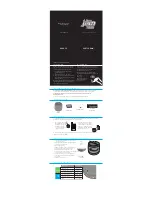
121
8
89
63
17
•
8
89
631
8
•
8
89
63
19
EN
INFORMATION ABOUT POWER INPUT
OF ELECTRICAL DEVICES
•
ATTENTION
y
The power input specified on the rating label of the
electrical device containing an electric motor is, in the
case of most electrical appliances, the expression of the
power of the electric motor, i.e. the load that the electric
motor can handle rather than expressing the power
input during standard method of use of the electrical
appliance, since the value of the power input increases
with the load placed on the electric motor.
Power electric motors in hand power tools have
a starting ramp up input power, which is greater than
the power input when a standard load is applied to the
electric motor, however, most of the time it does not
reach the power input specified on the rating label of the
electrical device or in exceptional circumstances exceeds
it by up to 30 % of the stated value. When a standard
operating load is applied to hand power tools, the power
input is below the value specified on the rating label. For
illustration, the starting power inputs and power inputs
during standard use of certain power tools and the mini-
mum required electrical power outputs of the generators
required to power them are provided in tables 3 and 4.
A typical example of electrical devices that differ from the
above-mentioned are those having a higher peak current
draw, such as compressors with a pressure vessel, high-pres-
sure washers with a higher power input and likewise this
may apply to certain electrical devices with electrical motors
with an older year of manufacture (see the serial number
on the rating label of the electrical device), the powering of
which requires the selection of a generator with an appro-
ximately 1 to 2 kW greater electrical power output than the
power input specified on the rating label of the electrical
device (see table 3), since the more powerful alternator of
the generator is able to cover the peak current surge.
y
In the event that a heating electrical device is connected to
the generator and the total power draw approaches or is
equal to the operating electrical power output of the gene-
rator, the specified electrical power output of the gene-
rator may not necessarily be achieved since, for example,
a hot air gun with manually adjustable temperature has
extremely rapid fluctuations in power input of up to 300 W
per second (this behaviour also occurs when it is powered
from the mains power grid) and the generator may not
necessarily be able to handle such rapid fluctuations in
power input, which manifests itself by a reduction in the
electrical operating power output of the generator. A heat
gun without temperature regulation normally has a stable
power input and this behaviour should not occur with it.
y
When selecting a generator based on its electrical
power output, the deciding factor is the power input
value specified on the rating label of the electrical
device, the year of manufacture of the electrical
device and the type of electrical device (compressor
with a pressure vessel, etc.) and the number of inten-
ded electrical devices that are to be powered from
the generator, since the power inputs of the indivi-
dual electrical devices are added up. The deciding
factor for the use of an electrical device with a power
input that is approaching the electrical power output
value of the generator should be the soft start func-
tion on the electrical device, which ensures a slower
ramp up of the electric motor and thereby reduces
the current spike that would otherwise not enable
the given electrical device to be used with the inten-
ded generator with a lower electrical power output.
y
Before purchasing a generator or connecting an
electrical device/s to the generator, to get a general
ideal, first use a standard wattmeter (device for mea-
suring electrical power consumption) both during
the start up of the electrical device as well as when
placed under the expected load from the mains
power grid (see table 3 and 4) and if possible, check
the use of this electrical device/s on a sample of the
generator being considered, since a wattmeter may
not necessarily be able to capture the peak current
ramp-up the duration of which is less than a second.
y
In table 3, there is a drawn up overview of the power
inputs of angle grinders with a cutting disc diameter
from 115 mm to 230 mm with the use of tools of the pro-
vided specification according to the determined purpo-
se of use of the angle grinders and requirements for the
minimum electrical power output of the generators.
Note
y
Tables 3 and 4 refer to the digital inverter generators
HERON® 8896216 and HERON® 8896217, which are not
part of our offer. The only reason why they are included
is that the described tests were performed on them
and they cannot be entirely compared to the respe-
ctive available models HERON® 8896218 and HERON®
8896219 for the following reasons. The current model
HERON® 8896218 (900 W/Max. 1 100 W) is equipped with
better electronics than model HERON® 8896216 and
handles loads better at full operating power output
than the original model HERON® 8896216. The current
model 8896219 (1850 W/Max. 2000 W) has, compared
to the previous model HERON® 8896217 (1600 W/max.
2000 W) a larger operating electrical power output. The
described digital generator models HERON® 8896216
and HERON® 8896217 thus better express the required
minimum electrical power output for the given load.















































